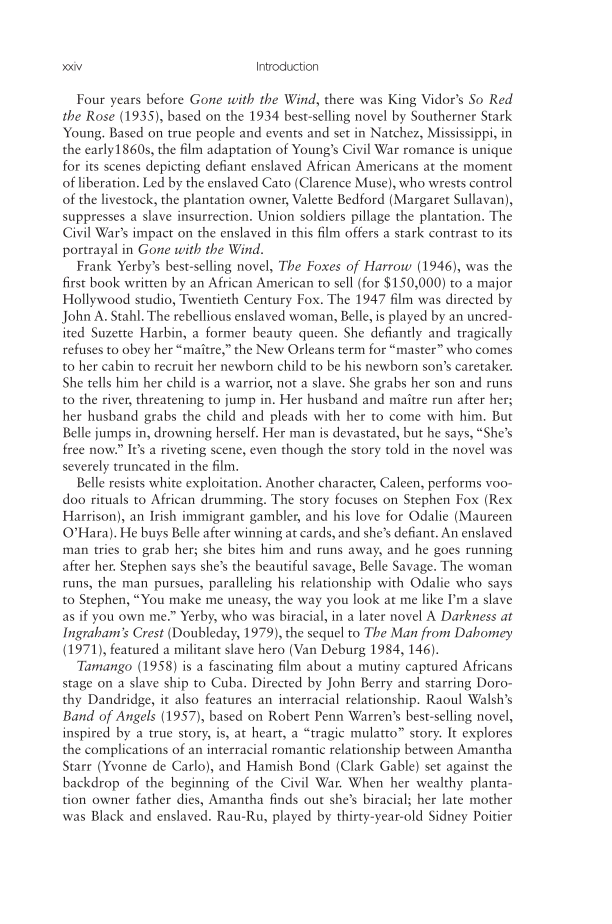xxiv Introduction Four years before Gone with the Wind, there was King Vidor’s So Red the Rose (1935), based on the 1934 best-selling novel by Southerner Stark Young. Based on true people and events and set in Natchez, Mississippi, in the early1860s, the film adaptation of Young’s Civil War romance is unique for its scenes depicting defiant enslaved African Americans at the moment of liberation. Led by the enslaved Cato (Clarence Muse), who wrests control of the livestock, the plantation owner, Valette Bedford (Margaret Sullavan), suppresses a slave insurrection. Union soldiers pillage the plantation. The Civil War’s impact on the enslaved in this film offers a stark contrast to its portrayal in Gone with the Wind. Frank Yerby’s best-selling novel, The Foxes of Harrow (1946), was the first book written by an African American to sell (for $150,000) to a major Hollywood studio, Twentieth Century Fox. The 1947 film was directed by John A. Stahl. The rebellious enslaved woman, Belle, is played by an uncred- ited Suzette Harbin, a former beauty queen. She defiantly and tragically refuses to obey her “maître,” the New Orleans term for “master” who comes to her cabin to recruit her newborn child to be his newborn son’s caretaker. She tells him her child is a warrior, not a slave. She grabs her son and runs to the river, threatening to jump in. Her husband and maître run after her her husband grabs the child and pleads with her to come with him. But Belle jumps in, drowning herself. Her man is devastated, but he says, “She’s free now.” It’s a riveting scene, even though the story told in the novel was severely truncated in the film. Belle resists white exploitation. Another character, Caleen, performs voo- doo rituals to African drumming. The story focuses on Stephen Fox (Rex Harrison), an Irish immigrant gambler, and his love for Odalie (Maureen O’Hara). He buys Belle after winning at cards, and she’s defiant. An enslaved man tries to grab her she bites him and runs away, and he goes running after her. Stephen says she’s the beautiful savage, Belle Savage. The woman runs, the man pursues, paralleling his relationship with Odalie who says to Stephen, “You make me uneasy, the way you look at me like I’m a slave as if you own me.” Yerby, who was biracial, in a later novel A Darkness at Ingraham’s Crest (Doubleday, 1979), the sequel to The Man from Dahomey (1971), featured a militant slave hero (Van Deburg 1984, 146). Tamango (1958) is a fascinating film about a mutiny captured Africans stage on a slave ship to Cuba. Directed by John Berry and starring Doro- thy Dandridge, it also features an interracial relationship. Raoul Walsh’s Band of Angels (1957), based on Robert Penn Warren’s best-selling novel, inspired by a true story, is, at heart, a “tragic mulatto” story. It explores the complications of an interracial romantic relationship between Amantha Starr (Yvonne de Carlo), and Hamish Bond (Clark Gable) set against the backdrop of the beginning of the Civil War. When her wealthy planta- tion owner father dies, Amantha finds out she’s biracial her late mother was Black and enslaved. Rau-Ru, played by thirty-year-old Sidney Poitier
Document Details My Account Print multiple pages
Print
You have printed 0 times in the last 24 hours.
Your print count will reset on at .
You may print 0 more time(s) before then.
You may print a maximum of 0 pages at a time.
















































































































































































































































